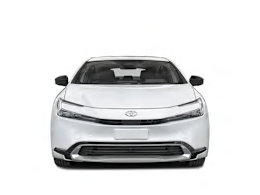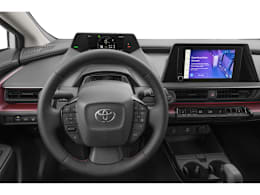We’ve always had a soft spot for the Toyota Prius at Consumer Reports. This hybrid model has never been flashy or sporty, but for the past two decades each generation came with two promises: Practical transportation and impressive fuel efficiency.
Toyota gave the Prius, and the Prius plug-in hybrid electric vehicle (PHEV) that we’re focused on with this road test, ground-up redesigns for the 2023 model year. (Note that the “Prime” nomenclature has been dropped beginning with the 2025 model year—it’s now simply referred to as the Prius Plug-in Hybrid.)
In addition to sleek, low-slung styling and surprisingly large 19-inch wheels on the XSE and XSE Premium trims (the base SE comes with 17-inch wheels) in an attempt to make it cooler and less nerdy, the Prius Plug-in Hybrid also has a more robust powertrain. All of these updates chip away at criticisms that the Prius is a slow, dowdy punchline.
But although the new Prius Plug-in Hybrid is quicker and more engaging to drive than before, the styling-led loss of cabin space and the skew toward performance have taken away from some of the attributes that have made the Prius line so special. Like the standard model, the Prius Plug-in Hybrid has a noisier interior, heavily compromised outward visibility, a lower-slung cabin that makes for more difficult entry and exit, a less comfortable rear seat, and reduced cargo room compared with the previous model.
In the words of one of our testers, “This car is trying to be too many things to too many of the wrong people.” In other words, those who have poked fun at the Prius in the past are still unlikely to buy this new one, and previous Prius owners may find the reworked version too impractical.
For consumers new to PHEVs, these are hybrids with larger batteries that can be plugged into a 120-volt outlet or 240-volt EV charger. This gives the vehicle a dedicated electric-only driving range (typically for about 20 to 40 miles, depending on the vehicle) for commuting and running errands, which is something that regular hybrids can’t do. When the battery is drained, the vehicle switches to regular hybrid operation. This also means that, unlike a full battery-electric vehicle, there is no need to find a public charger on a long trip because the gas engine takes over once the electric range is used up.
For buyers who are nervous about going all-in for an EV, a plug-in hybrid could be a logical and cautious step toward electrification. PHEVs make especially good sense if you have a short commute to work, rarely drive long distances, and have the ability to plug in your vehicle at home to charge overnight—it’s bound to save you lots of money at the gas pump. Plus, unlike regular hybrids, a PHEV may be eligible for federal tax credits. Also consider that the average American drives less than 40 miles per day, which means many people will be able to do most of their daily commute on electric power while reserving the gas engine for longer trips.
Toyota gave the Prius Plug-in Hybrid upgrades where it matters the most: The powertrain. The new Prius Plug-in Hybrid has a 13.6-kilowatt-hour lithium-ion battery compared with the 8.8-kWh battery in the previous-generation, which gives it a longer electric-only range and more robust electric propulsion. It also has a larger four-cylinder gasoline engine, now at 2.0-liters, and a 120-kW electric motor, with the two combining to produce 220 horsepower, a significant 99-hp boost compared to the last Prius Prime.
In spite of the flashy new styling, powertrain efficiency is still the Prius Plug-in Hybrid’s focus. Our tested midlevel XSE has an EPA-estimated 39-mile electric-only driving range—a big improvement over the 25 miles of EV driving the previous plug-in version was rated at. Once the EV portion was depleted, we measured 43 mpg overall with the Prius Plug-in Hybrid operating in its hybrid mode. Of note, that’s a significant drop from the 51 mpg overall we got with the regular Prius XLE all-wheel-drive model we also tested. But, the Prius Plug-in Hybrid is also about 240-pounds heavier than that car. (The Prius Plug-in Hybrid is only available with front-wheel drive.)
The fuel-economy difference is likely to be even greater when compared to a front-drive Prius (particularly the base LE guise), which are even more sparing with fuel, according to the EPA. This just further hits home the importance of plugging in your Prius Plug-in Hybrid as often as possible in order to reap the maximum efficiency benefits of the electric miles.
It takes just over four hours to recharge the Prius Plug-in Hybrid on a 240-volt (Level 2) EV charger. Using the supplied mobile charging cable plugged into a 120-volt household outlet, it took us about 10 hours to charge it, which allows owners to avoid the expense of buying and installing a dedicated EV charger.
Despite the extra weight it’s carrying around due to the larger battery, the Prius Plug-in Hybrid is a very quick car. It covered our 0 to 60 mph acceleration test in just 6.9 seconds. That’s almost a full second quicker than the regular Prius, and a nearly four-second improvement (!) over the previous-generation Prime.
Out on the road, the Prius Plug-in Hybrid is a pleasure to drive in EV mode because the noisy gas engine stays off. Plus, there’s enough electric power for around-town driving, and even for getting up to speed onto the highway. It’s only if you get close to full throttle that the gas engine kicks on to bring additional power.
When the 39 miles of electric range is used up, the Prius Plug-in Hybrid transitions to a regular hybrid operation, seamlessly switching back and forth between electric and gas modes as needed. But when extra power is called for out on the open road—such as quick merging, getting around slower traffic in a two-lane passing zone, or climbing a hill at highway speeds—the gas engine kicks on with a loud and raspy groan, which sours the driving experience. Toyota’s electronic continuously variable transmission (eCVT) only serves to amplify the din, as it allows the engine revs to rise very high in a rubber band-like fashion, without any simulated upshifts as with some CVTs. In those instances, the Prius feels loud and unrefined.
We enjoy the car’s newfound nimbleness thanks to tighter suspension tuning, which endows the car with more capable handling. We found it agile through corners out on the road and very secure when pushed to its limits around our track. It posted an impressive speed of 56.5 mph through our tough avoidance maneuver test.
One benefit the Prius Plug-in Hybrid has over the regular Prius is ride comfort. Even with the large 19-inch wheels and tires that came on our tested XSE, the suspension did a good job smoothing out most bumps. This likely is aided by the extra weight the Prius Plug-in Hybrid is hauling around, which goes a long way to making the car feel more settled when the going gets rough.
The new lower-slung aerodynamic body looks super sleek, and very different from any other Prius before. But it exacts a price when it comes to entering the car, requiring a lot of ducking and “falling down” into the seats to get in. Exiting is a similarly frustrating experience, requiring you to hoist yourself back up for a less-than-graceful exit. The high, vertically-oriented rear door handles are also awkward to grab when trying to get in.
The odd driving position of the regular Prius is the same for the PHEV. You sit very low, reminiscent of a sports car. In front of you is a dramatically-raked windshield, and visibility is hampered by extremely thick windshield pillars. Plus, the driver’s instrument screen is far away. On the bright side, its faraway location—like a compromise between a traditional instrument cluster and a head-up display on the windshield—allows the driver to keep their eyes focused forward toward the road ahead, rather than looking down at a screen. But the text on the gauge display isn’t any larger even though it's farther away from you. Plus, it’s crowded with information, and many drivers felt like they had to look up and over the top of the panel, as well as over the large windshield wipers.
The front seats are comfortable with reasonably soft cushions and supportive side bolsters to hold you in place—helpful considering the Prius’ newfound cornering capability. The rear seat is tighter than before, though. It’s situated low to the floor, resulting in very little underleg support. Even with the seat’s low position, headroom will be tight for average-sized adults and up. Cargo room has also been downgraded: We could fit only two large suitcases behind the rear seat—with the last Prius we fit those, plus two large duffel bags.
The Prius line shares much of its interior layout and controls with other Toyota models. The climate system is controlled via manual buttons, which we appreciate seeing instead of the increasingly-common touch-capacitive “buttons” on a panel. But we were a bit irked by the small climate labels, which are difficult to decipher while driving.
The SE and XSE come standard with an 8-inch infotainment touchscreen like we had in our regular Prius. There we found it to be responsive to inputs and easy to read at a glance. But unlike some competitors it doesn’t have a “home” screen, or split-screen functionality that allows for simultaneous viewing of things like navigation and media. Our Prius Plug-in Hybrid test car was fitted with the optional 12.3-inch touchscreen, which is standard on the top-trim XSE Premium. It has much of the same positives and negatives as the smaller touchscreen, but the larger screen provides more room for text and icons. In addition, the power/volume knob is inconveniently moved to the far-right side of the display in models with the larger screen; it’s on the left, closer to the driver, with the 8-inch screen.
One handy feature we really liked is the phone-holder slot that also acts as the wireless charger, located on the passenger side of the center console. However, drivers routinely had problems with the wireless pairing of phones to the Android Auto and Apple CarPlay systems. The system would lose connection during drives or not recognize the phone on subsequent trips, requiring the driver to unpair and then re-pair their phone. And the stubby electronic “monostable” gear selector is likely to be confusing at first, due to the odd way you move the lever between Reverse and Drive.
The Prius comes with the “Toyota Safety Sense 3.0” suite of active safety and driver assistance systems. Standard features on the Prius include automatic emergency braking with pedestrian, cyclist, and motorcycle detection, automatic emergency braking that operates at highway speeds, blind spot warning, rear cross traffic warning, lane centering assistance, lane departure warning, lane keeping assistance, adaptive cruise control, and automatic high beams.























